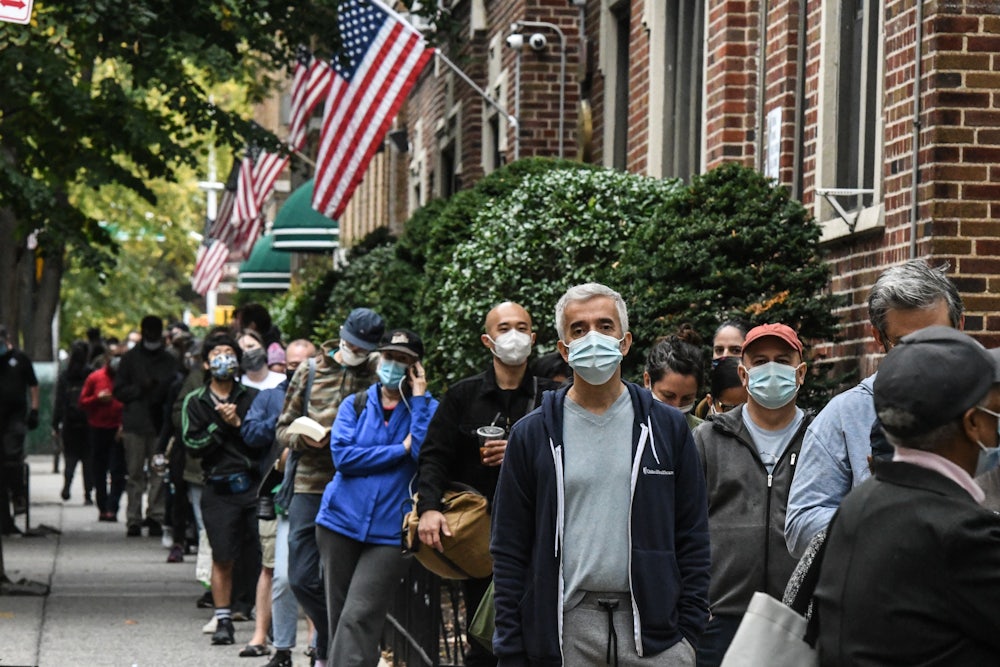Standing in front of a gaggle of press on a New York City sidewalk, Representative Alexandria Ocasio-Cortez assessed the situation playing out during the city’s first three days of early voting in the 2020 general election—lines wrapping around the block, people being forced to stand for hours just to cast their ballot—and called the mess for what it was: voter suppression. “There is no place in America that two-, three-, four-hour waits to vote is acceptable,” Ocasio-Cortez said. “Just because it’s happening in a blue state doesn’t mean that it’s not voter suppression.”
The pandemic has upended all kinds of otherwise mundane activities, including how we vote. Already, voters in major swing states and elsewhere have turned in absentee ballots and showed up for early voting at record rates. And it would be nice, relatively speaking, to believe that the pandemic was the main reason voting is such a slog this year. But this isn’t a new problem. Disenfranchisement and voter suppression have been a consistent issue for years in New York, and mismanagement has run rampant throughout New York City’s Board of Elections. It’s part of the same anti-democratic tendency that animates conservatives in red states, but with a liberal twist: Low turnout serves Democratic incumbents well in safely blue states. That’s why we’re in this mess.
In January 2019, New York Governor Andrew Cuomo finally put his pen to voter-participation legislation drawn up by the state Assembly. With his signature, the state enacted a series of bills aimed at opening up the ballot box. One bill provided the option of in-person early voting up to 10 days before an election. Others preregistered teenagers applying for a drivers’ permit, automatically transitioned voters who moved in-state, moved the primaries up three months, and limited LLC campaign contributions. In effect, the New York election systems were given a decades-overdue overhaul. It couldn’t have come soon enough.
The year before, in 2018, New York’s byzantine system was on full display. The primary elections for state and federal offices were scheduled on two separate days—making New York the only state in the nation to follow such a calendar. The state also didn’t have an early voting program in place, one of just a dozen states on that list, leading to monstrous lines on Election Day. There were also widespread reports of broken voting machines, further extending the process for voters. The same was true for the 2016 elections.
Line to vote already around the block in Ditmas Park at 7am #Election2016 @DNAinfoNY pic.twitter.com/aunmb1azi8
— Kathleen Culliton (@K_Culliton) November 8, 2016
This had become the norm for New Yorkers, a necessary evil that voters in the city had to learn to live with and navigate around, lest they forgo their participation. Prior to the election of President Trump in 2016, it was difficult to imagine the electoral calculus in the state Assembly changing in a drastic enough manner to result in the updates.
This is where New York’s uniquely bipartisan fuckery rears its head. Ahead of New York’s disastrous 2018 election process, as in the decades before it, the Assembly was controlled by the Democratic Party, which had actually already drafted and passed versions of the early voting legislation. But the Republican-controlled state Senate—the Democratic Party held a majority, but a splinter group, calling itself the Independent Democratic Conference, had caucused with Republicans over the past decade, giving conservatives a slim voting majority—stood against the update, citing unfounded concerns of voter fraud and the financial burden to the taxpayer. The bills never made it through the Senate.
The 2018 primaries helped fix the Republican problem with the defeat of many IDC incumbents by progressive Democrats. With IDC members absolutely and gloriously wrecked, there were no excuses left not to take on voter expansion efforts. And that’s how, come January 2019, the bills were finally passed.
This hasn’t entirely fixed the problems inherent to New York’s voting system, though. As The New York Times detailed in a recent piece, the New York City elections board, rife with nepotistic hires tapped by political leaders, has bungled the rollout of mail-in ballots during both the primaries and the general election this year. And though early voting remains a popular option—as evidenced by the long lines—there are still thousands of New Yorkers who may not be able to participate in person while coronavirus rates rise, leaving their vote in the hands of an election board whose own people, like Charles Stinson, are comfortable publicly declaring it, “chronically dysfunctional.”
What New Yorkers are experiencing now is the residual effect of their voting system being held hostage for a decade and their local election officials being the partner or cousin or drinking buddy of the local party bosses. The new laws that finally came in 2019 were not fixes to New York as it existed then and now; they were laws that could have helped the state’s election infrastructure of 2010. And the decision to abandon the Tammany Hall–esque appointment style of the election board in the nation’s largest city should have come with the death of Tammany Hall.
Returning to the words of Ocasio-Cortez, whether voter suppression is intentional or not is almost a secondary concern. If you can’t vote, you can’t vote. “At the end of the day, if the line at your polling place is so long that you don’t vote—that is a form of disenfranchisement,” she said. By others and their own hand, New York’s election officials are stuck playing a game of catch-up. So far, only the voters are losing.
